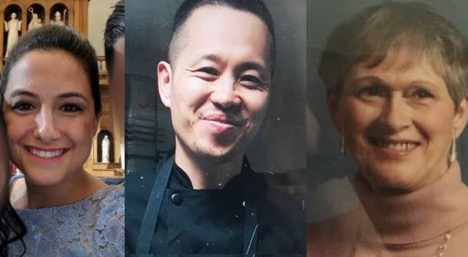President’s Column for the Positive Living Newsletter (May 2018). Read the rest of the newsletter here.
 On May 6, I did a one-hour interview at the Fairchild TV Studio in Richmond Hill, Ontario, for their program Leisure Talk (大城小聚), which features special guests discussing topics of interest to the Chinese community in Canada. My topic happened to be meaning therapy as a way to help people live better and happier lives in difficult times.
On May 6, I did a one-hour interview at the Fairchild TV Studio in Richmond Hill, Ontario, for their program Leisure Talk (大城小聚), which features special guests discussing topics of interest to the Chinese community in Canada. My topic happened to be meaning therapy as a way to help people live better and happier lives in difficult times.
This topic could not be timelier because, on April 23, 2018, Toronto witnessed the deadliest van attack in Canadian history, with 10 people dead and 16 critically injured. Young, 25-year-old man Alek Minassian was alleged to have driven a rented van at speed through the North York City Centre business district and deliberately hit pedestrians, targeting mostly women.

Three of the ten victims from the van attacks: Anne Marie D’Amico, Eddie Kang, and Dorothy Sewell.
More than 15 years ago, I wrote a 12-step survival guide based on meaning therapy after the 2004 India Ocean earthquake and tsunami disaster. In the intervening years, meaning therapy has become more refined and widely known. I want to take this opportunity to focus on the aspects of meaning therapy that are most relevant to the survivors of the Toronto van attack.
You Need Meaning When Your Life Falls Apart
On a bright and sunny Monday afternoon, just before 1:30 pm, when people were going about the business of daily living, such as walking, shopping, or going back to work after lunch, the unexpected tragedy struck. Within a few minutes, many people’s lives were changed forever. This horrible incident reminds all of us that life is brief and fragile.
When life goes on smoothly and everything is simple, there seems to be no need to wrestle with existential concerns. Most people are happy to live their simple but shallow lives, revolving around “eat, drink, work, and be happy.” Unfortunately, even when living in one of the safest cities, bad things can still happen to innocent people. If we do not have an adequate philosophy of life and have not discovered the meaning of suffering, we will not be able to cope with the horrors of life, which will shatter our assumptive world (Janoff-Bulman, 1992) and plunge us into an existential crisis.
Therefore, it is important for us to reflect on the important meaning of life questions, such as: How can I make the best use of my life? Am I willing to make personal sacrifices for a better future? Do I still have reasons for living, even when my life is full of pain and suffering? What is the value of my life?
Negatively- and Positively- Oriented Meaning-Seeking
Only when negative things happen to us do we spontaneously ask why questions (Wong & Weiner, 1981). This negativity bias is hardwired in us for our survival. Such negatively-oriented meaning-seeking motivates us to find reasons and solutions for problems; more importantly, it forces us to confront the painful truth about the dark side in our own lives.
Bad things are effective in waking us up from our own complacency and self-deception; they also challenge the adequacy of our existing beliefs and values. They expose the shallowness and emptiness of a self-centered and pleasure-oriented lifestyle. They force us to ask the tough questions, such as: If I were to die now, have I really lived? Shall I pursue something more meaningful than just making a living? What really matters?
Thus, negative events eventually lead to positively-oriented meaning-seeking, which motivates us to discover our true purpose in life and our role in this world. It is the process of striving towards some worthy future goals that make us feel fully alive and contributes to our personal growth. In short, meaning therapy is based on a two-factor theory of meaning-seeking (Wong, 2018a).

How we interpret what happens to us is more important to what actually happens to us. People may attribute different meanings to the same event. For example, some may attribute the van attack to Islamic terrorism, leading to more biases against Muslims. Some may attribute it to mental illness, leading to greater concern for mental health.
Similarly, the van attack may be viewed as an isolated incident, but for someone who has experienced past traumas, this incident may open the floodgates of terrifying memories which have been hidden for years.
Different Ways of Meaning-Making
In agreement with Frankl, I believe that meaning cannot be arbitrarily created; it can only be discovered through meaning-seeking. However, I also believe that meaning-seeking automatically leads to meaning making through Frankl’s creative, experiential, and attitudinal values. The main functions of meaning-making are:
- Making sense of what happens to us and around us;
- Making sense of our own life across the entire lifespan by creating a coherent life story;
- Making sense of the world in which we live and the vast universe;
- Creating something of value to our own life and to humanity;
- Making improvements each day towards our life goal;
- Appreciating what life offers and enjoying the small victories each day; and
- Taking responsibility to choose life goals that make life better.
In short, these functions represent Wong’s (2012a) PURE model of meaning, which consists of Purpose, Understanding, Responsibility, and Enjoyment. These components are also based on Frankl’s three values of meaning making.
- The creative value has to do with contributing something of value to society based on each individual’s unique personality and skillset. Thus, we create meaning through what we do with our hands, head, and heart. When our hearts are pure, our thoughts are noble, and our actions are based on our creative ideas, then whatever we do will have value and meaning, no matter how small.
- The experiential value enables us to see life and suffering as meaningful. This is possible, only we see everything with the meaning mindset (Wong, 2012b) and existential gratitude (Wong, 2016a). The meaning mindset enables us to discover hidden potentials for meaning in every situation and thus allows us to do something that is responsible and morally good.Similarly, if we see everything through a lens of appreciation and gratitude, our lives will be enriched and blessed, because then we give thanks not only for the good things in life, but also for the bad things that break our hearts. At a deeper spiritual level, our existential gratitude can encompass a great many things for which we can count our blessings. Here is a brief sketch of existential gratitude:
- I am thankful for having survived a horrible tragedy.
- I am thankful for all the love and kindness in times of grief and sorrow.
- I am thankful for the promises of a better tomorrow.
- I am thankful for being alive and learning to grow spiritually.
- I am thankful for my past lessons, future opportunities, and the present moment of breathing, working, and connecting with others.
- I am thankful for all the beauty, sustenance, and resources from nature.
- I am thankful to all the people who make my life possible.
- I am thankful to God, the source of life and all blessings.
- The attitudinal value of defiance and courage is needed for living a meaningful life. When we are confined in a hospital or cut off from all opportunities for creative and experiential values, we can still take a heroic stance and keep our chin up because of the intrinsic values and dignity of being a human. An attitude of grit is also based on the belief that what we stand for and what we pursue is worth suffering and dying for. The conviction in the value of our pursuit and the faith that God will be our help no matter what happens will make us fearless. Wong’s (2018b) four-factor theory of grit emphasizes courage and faith as the foundation of persistence and passion.
A variety of meaning-focused coping strategies include the following:
- Reframing involves cognitive reconstruction to transform negative events via a positive light. The simplest way is reframing, such as seeing a problem as a challenge, a failure as a lesson, an ending as an opportunity for a new beginning, or a tragic loss as a heroic triumph.
- Another way is to reframe the problem into a larger and more meaningful story. For example, I can link my present struggle against a much more powerful adversary to the Biblical story of David against Goliath.
- A more demanding method is expressive writing (Pennebaker, 1997). Journaling about the problems in our daily lives can heal our emotional pains. The most cognitively and emotionally demanding task is to do life review (Wong, 1995) and author a positive coherent life story that incorporates all the negative incidents in life. Through life review, we discover the enduring beliefs and values, order and coherence of our own life. This exercise enables us to create a more realistic and hopeful future by incorporating the losses and tragic events in our lives.
The Importance of Understanding Life as a Dialectic Process
The world does not exist in black and white. A binary way of thinking often gets us into trouble. A more realistic and wiser way of looking at the world is in terms of navigating between two polarities and finding the middle way between negatives and positives or between yin and yang.
Everything in life exists in polarity (Wong, 2016b)—action and reaction, positive and negative, love and hate, hope and despair, virtue and vice, ebb and flow. Life is learning to navigate between polarities to find the right balance in every situation and still move forward and upward through the dual-system process (Wong, 2012a), motivated by self-transcendence.

The Need for a Double Vision
Meaning therapy emphasizes the importance of having a double vision of focusing on the present situation and at the same time keeping in mind one’s ideals and life goals (Wong, 2012c). A double vision prevents us from being obsessed with a present problem or being carried away by dreaming about a distant future. It also prevents us from looking at the tree but forgetting the forest. In sporting terms, we not only need to keep on an eye on the ball we carry, but also an eye on the goal post.
To practice a double vision, we need to cultivate a meaning mindset and self-transcendent motivation as the two pillars for continued personal development. A meaning mindset enables us to discover what is good, beautiful, and true even in a miserable situation; this will help us to discover the hidden meaning that makes life worth living. The spiritual motivation of self-transcendence enables us to aim high and shift from egotistic concerns towards serving God and caring for others. Both of these exercises help us develop the vertical dimension of life and make us more spiritual.
Conclusion
I hope that the above highlights of meaning therapy will be of help to all of you who are struggling with some personal issues or coping with the aftermath of some traumatic events. I also hope that I can meet all of you at the forthcoming 2018 Meaning Conference to further investigate the recent developments in meaning-centered counselling and therapies.
References
- Janoff-Bulman, Ronnie (1992). Shattered assumptions: Towards a new psychology of trauma. New York, NY: Free Press.
- Pennebaker, J. W. (1997). Writing about emotional experiences as a therapeutic process. Psychological Science, 8(3), 162-166. https://doi.org/10.1111/j.1467-9280.1997.tb00403.x
- Wong, P. T. P. (1995). The processes of adaptive reminiscence. In B. K. Haight & J. D. Webster (Eds.), The art and science of reminiscing: Theory, research, methods, and applications (pp. 23-35). Philadelphia, PA, US: Taylor & Francis.
- Wong, P. T. P. (2012a). Toward a dual-systems model of what makes life worth living. In P. T. P. Wong (Ed.), The human quest for meaning: Theories, research, and applications (2nd ed., pp. 3-22). New York, NY: Routledge.
- Wong, P. T. P. (2012b). The meaning mindset: Measurement and implications. International Journal of Existential Psychology and Psychotherapy, 4(1), 1-3.
- Wong, P. T. P. (2012c). From logotherapy to meaning-centered counseling and therapy. In P. T. P. Wong (Ed.), The human quest for meaning: Theories, research, and applications (2nd ed., pp. 619-647). New York, NY: Routledge.
- Wong, P. T. P. (2016a). Integrative meaning therapy: From logotherapy to existential positive interventions. In P. Russo-Netzer, S. E. Schulenberg, & A. Batthyány (Eds.), Clinical perspectives on meaning: Positive and existential psychotherapy (pp. 323-342). New York, NY: Springer.
- Wong, P. T. P. (2016b, October 18). The good life through polarity and transcendence (Part 1 of 2). The Virtue Blog. Retrieved from https://thevirtueblog.com/2016/10/18/the-good-life-through-polarity-and-transcendence-part-1/
- Wong, P. T. P. (2018a, May 11). Two-factor theory of search for meaning. Dr. Paul T. P. Wong. Retrieved from http://www.drpaulwong.com/two-factor-theory-of-search-for-meaning/
- Wong, P. T. P. (2018b, May 11). Four-factor theory of true grit. Dr. Paul T. P. Wong. Retrieved from http://www.drpaulwong.com/four-factor-theory-of-true-grit/
- Wong, P. T. P., & Weiner, B. (1981). When people ask “Why” questions and the heuristic of attributional search. Journal of Personality and Social Psychology, 40(4), 650-663.
Cite
Wong, P. T. P. (2018, May 17). Meaning therapy and the Toronto van attack. Positive Living Newsletter. Retrieved from http://www.drpaulwong.com/meaning-therapy-and-the-toronto-van-attack

 Meaning Conference 2025 will be the INPM’s first in-person conference with a virtual option after the pandemic.
Meaning Conference 2025 will be the INPM’s first in-person conference with a virtual option after the pandemic.